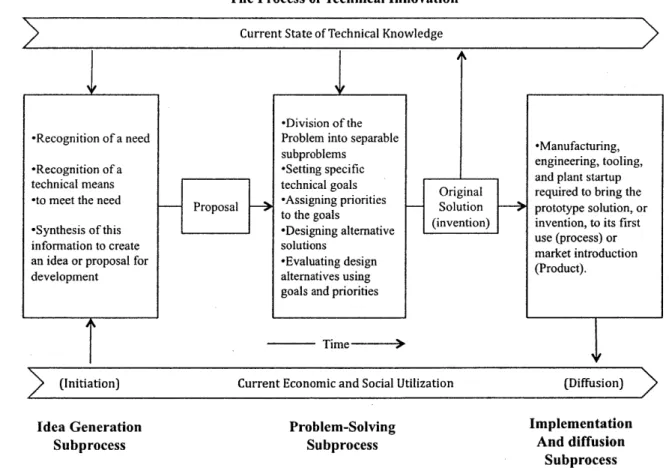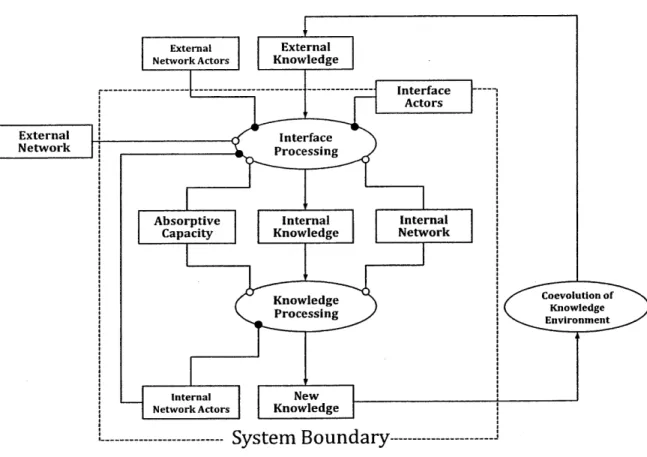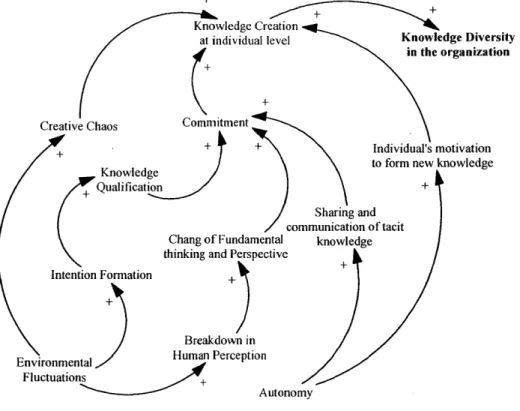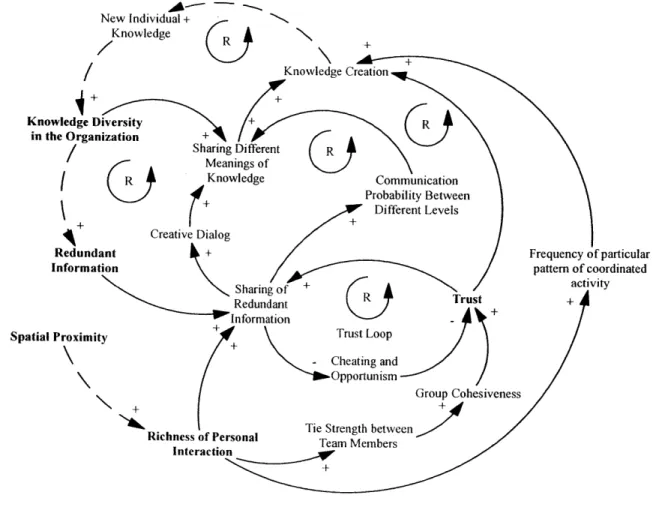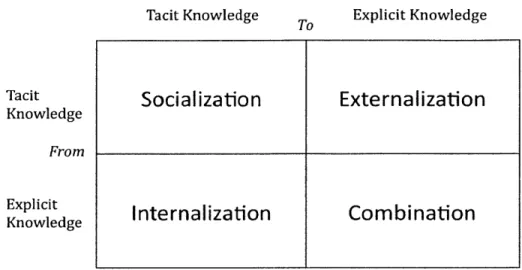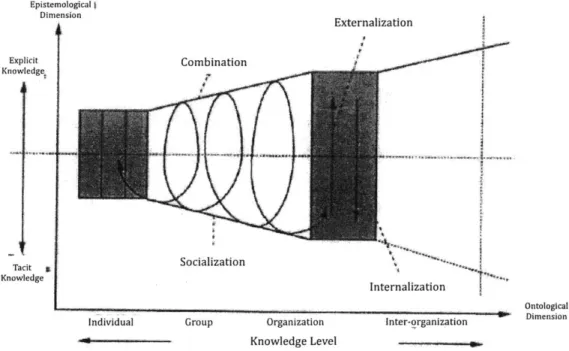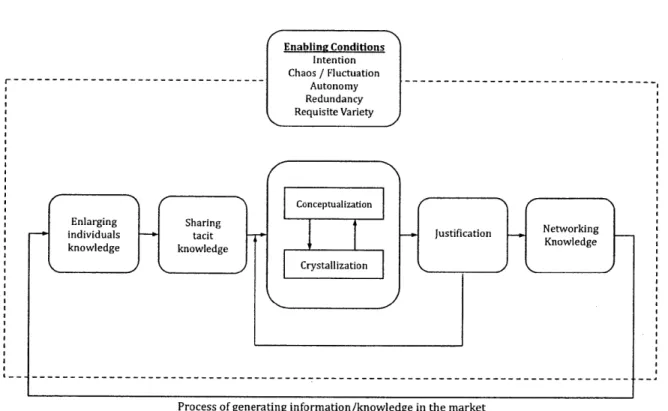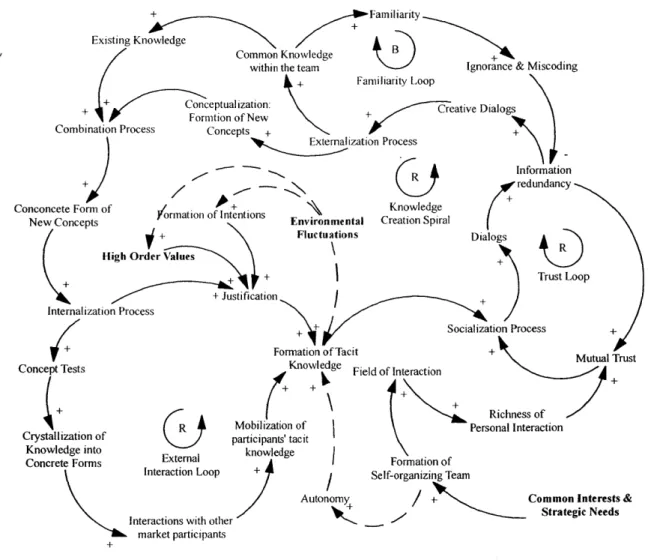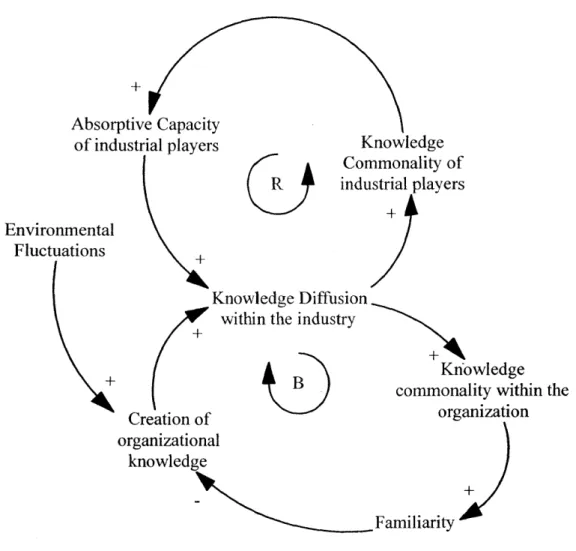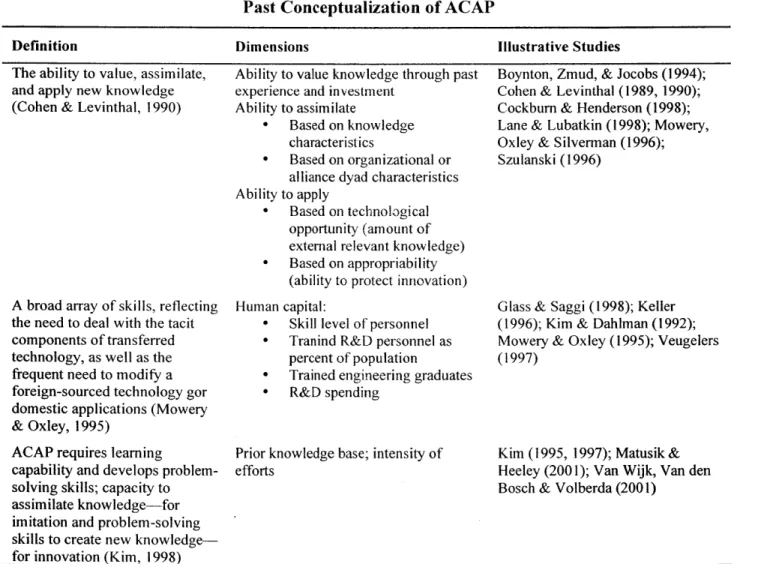Dynamics and Architectures of Innovation Systems
ByPO CHIA CHEN M. S. Chemical Engineering National Cheng Kung University (1997)
SUBMITTED TO THE ENGINEERING SYSTEM DIVISION
IN PARTIAL FULFILLMENT OF THE REQUIREMENTS FOR THE DEGREE OF
MASTER OF SCIENCE IN ENGINEERING AND MANAGEMENT
AT THE
MASSACHUSETTS INSTITUTE OF TECHNOLOGY
FEBRUARY 2011
C201 I Po Chia Chen All rights reserved.
The author hereby grants to MIT permission to reproduce and to distribute publicly paper and electronic copies
of this thesis document in whole or in part in any medium now known or hereafter created.
ARCHES
MASSACHUSETTS INSTIUTEF OF TECE OLOGYJUL
2
0 2011
t- I Signature of Author: , , ,, p,-Engineering System Division
January 14th 2011
Certified by:
C ert fi ed by:Jam
es M . U tterback
David J. McGrath jr (1959) Professor ement and Innovation, and Professor of Engineering Systers
,
r>
f)
Thesis SupervisorAccepted by:
Pat. Hale
Table of Contents
A B ST R A C T ... 5
CHAPTER 1 INTRODUCTION ... 7
1.1 The Process of Technical Innovations ... 7
1.2 The Definition of knowledge ... 9
1.3 Dimensions of Knowledge...9
1.4 The Architecture of Innovation Processes...12
CHAPTER 2 KN OW LEDGE CREATION PROCESSES ... 15
2 .1 E nabling C ond itions...15
2.2 Spiral of Knowledge ... 23
CHAPTER 3 ABSORPTIVE CAPACITY... 36
CHAPTER 4 INTRAORGANIZATIONAL NETWORK ... 47
CHAPTER 5 INTERORGANIZATIONAL NETWORK... 64
CHAPTER 6 EFFECTS OF SPATIAL PROXIMITY ON NETWORKS... 71
CHAPTER 7 KNOWLEDGE SEARCH AND TRANSFER IN THE NETWORK... 79
CHAPTER 8 INTERFACE PROCESSING ... 84
8.1 Gatekeepers and Boundary Spanners...84
8.2 Boundary Objects...85
CHAPTER 9 CON CLUSIONS AND DISCU SSION S... 89
9.1 Conclusions and Discussions...89
9.2 Directions for Future Researches...95
Table of Figures
Figure 1-1 Process of technological innovation within the firm (Source: Utterback 1971)...8
Figure 1-2 High-level architecture for the innovation system ... ... 14
Figure 2-1 Causal loop diagram for knowledge creation at individual level...17
Figure 2-2 Effects of redundant information, Richness of Personal Interaction, and Trust...21
Figure 2-3 Modes of knowledge conversion (Source: Nonaka 1994)...24
Figure 2-4 Spiral of organizational knowledge creation (Source: Nonaka 1994) ... 28
Figure 2-5 Organizational knowledge creation process (Source: Nonaka 1994) ... 29
Figure 2-6 System Architecture for knowledge processing...31
Figure 2-7 Dynamics of the knowledge creation process ... 33
Figure 2-8 Equifinality of knowledge creation in a stable environment...35
Figure 3-1 A model of absorptive capacity (Source: Zahra and George 2002) ... 42
Figure 3-2 System architecture for absorptive capacity...43
Figure 3-3 Dynamics between absorptive capacity and knowledge creation... ... 46
Figure 4-1 Relations between social capital and value creation (Source: Tsai and Ghoshal 1998) ... 49
Figure 4-2 Formation of intraorganizational networks...52
Figure 4-3 Coevolution of absorptive capacity and knowledge environment (Source: Van den Bosch, Volberda and d e B o er 19 9 9)...5 3 Figure 4-4 Coevolution of intraorganizational networks and their knowledge environment...54
Figure 4-5 System Architecture for the formation of intraorganizational networks...55
Figure 4-6 A conceptual model for understanding cultural constraints on technology transfers across nations (Source: K edia and Bhagat 1988) ... 59
Figure 4-7 Dual effects of technology and coevolution of social capital with the knowledge environment...62
Figure 4-8 System Architecture for the development of social capital ... 63
Figure 5-1 The endogenous dynamic of interorganizational networks (Source: Gulati and Gargiulo 1999)...65
Figure 5-2 Dynamics of intrerorganziational network formation ... ... 69
Figure 5-3 System architecture for interorganizational network formation...70
Figure 6-1 The effect of sharing or not sharing a department (Data takenfrom a single organization) (Source: Allen 19 9 7) ... 72
Figure 6-2 Combining the effects of organizational and physical separation or proximity (Source: Allen 1997) ... 73
Figure 6-3 Probability of regular technical communication as afunction of departmental size (Source: Allen 1997) ... 73
Figure 6-4 The relationship between telephone andface-to-face communication between locations (Source: Allen and H aup tm an 1989) ... 75
Figure 6-5 Knowledge commonality, spatial proximity, strategic relatedness and relational dimension of social cap ita l ... ... 76
Figure 6-6 Effects of spatial proximity on the dynamics of intraorganizaional network formation...77
Figure 7-1 Search and transfer effects associated with four combinations of knowledge complexity and tie strength (Source: H ansen 1999) ... 82
Figure 7-2 Dynamics of knowledge search and transfer in the network ... ... 83
Figure 8-1 System Architecture for Interface Processing...88
Figure 9-1 High-level consolidated dynamics for the innovation process...93
Figure 9-2 High-level consolidated system architecture for the innovation process ... 94
Table of Tables
Table 3-1 Past conceptualization of absorptive capacity (Source: Zahra and George 2002)...41Table 4-i Three basic organizationforms, dimensions of knowledge absorption and absorptive capacity(Source: Van den Bosch, Volberda and de Boer 1999) ... 58
Table 4-2 An examination ofthe relative importance of cultural variation and strategic management processes as determinants of the successful transfer of technology across nations (Source: Kedia and Bhagat 1988)...60
Dynamics and Architectures of Innovation Systems
By
PO CHIA CHEN
Submitted to the Engineering System Division on January 141h, 2011 in partial fulfillment of the
requirements for the degree of Master of Science in Engineering and Management
ABSTRACT
Innovation processes are multifaceted. Different studies usually focus on different facets of innovations without being integrated into a complete innovation system. In this thesis, system dynamics and system architecture approaches are adopted to integrate different studies in innovations and to develop a more holistic view of innovation systems.
Three key elements, knowledge diversity, spatial proximity, and strategic relatedness, are found to be fundamental to innovations after analyzing and comparing different studies. However, these three factors derived from resource-based view and knowledge-based view do not seem sufficient to explain the evolutionary behaviors of innovations. Therefore, another two factors, mutation mechanisms and dynamic capabilities, are proposed to supplement the original three factors in the analysis of innovation systems.
Thesis Supervisor: James M. Utterback
Title: David J. McGrath jr (1959) Professor of Management and Innovation, and Professor of Engineering Systems
Chapter 1 Introduction
1.1 The Process of Technical Innovations
In the resource-based view of the firm (Wernerfelt, 1984), it is suggested that a firm's competitive advantages derive from the possession of specific resources, competences, or capabilities. Those that can lead to competitive advantages, by definition, must be scarce, valuable, and durable (Barney, 1991), and be appropriable by the firm. The primary task of the firm is to maximize the value generation through the optimal deployment of its idiosyncratic bundle of resources and at the same time develop new resource base for the future. However, in an efficient market, these rent-yielding resources or capabilities must originate within the firm for them to be valuable and appropriable. Since all the tangible resources are available in the market and are not appropriable by the firm, it follows that the competitive advantages of the firm must originate from the intangible firm-specific knowledge with which the firm can add values to tangible input factors or create values by the applications of these tangible factors. Based on this perspective, a knowledge-based theory of the firm is being developed.
Nowadays, in this fast changing "information age," intangible knowledge is playing an even more important role in technological innovation that continually re-shapes the world. How does knowledge affect the technological innovation? Utterback (1971) proposed a model for the process of technological innovation within the firm (Figure 1-1). In his model, the technological innovation process includes three phases: idea generation, problem solving, and implementation, possibly followed by diffusion. In each of the three phases, information from technical or environments flows through the boundary to the firm to facilitate the synthesis of knowledge that is necessary for the technological innovation. The information, no matter technical or environmental, involved in this process can be classified knowledge as long as the information is regarded as "justified true belief." Within the boundary of the firm, different types of knowledge also flow between different phases of technological innovation process. In this model, the whole technological innovation process is comprised of different knowledge-processing activities. It implies that in many modem firms where technological innovation has become the key element of competitive advantages, not only the componential knowledge itself but also the knowledge of
knowledge-processing (procedural knowledge) from a system level will both affect the performances of technological innovation and hence the performances of the firm.
Utterback's model has provided us some ideas about the role of knowledge in the technological innovation process. In this thesis I will expand his model to tentatively set up a conceptual generalized model to reify the dynamics of technological innovation under different knowledge conditions. Since knowledge will be the key objective of our analysis in this thesis, it's important to clarify the following characteristics of knowledge to lay the foundation for the subsequent discussions.
The Process of Technical Innovation
Current State of Technical Knowledge
-Recognition of a need
-Recognition of a technical means 'to meet the need -Synthesis of this information to create an idea or proposal for development
Proposal
-->
(Initiation)-Division of the Problem into separable subproblems 'Setting specific technical goals -Assigning priorities to the goals -Designing alternative solutions -Evaluating design alternatives using goals and priorities
Time->
Original Solution (invention)
Current Economic and Social Utilization
Idea Generation Subprocess Problem-Solving Subprocess -Manufacturing, engineering, tooling, and plant startup required to bring the prototype solution, or invention, to its first use (process) or market introduction (Product). (Diffusion) Implementation And diffusion Subprocess Figure 1-1 Process of technological innovation within the firm (Source: Utterback 1971)
1.2 The Definition of knowledge
The concept of knowledge has intrigued many great thinkers without the emergence of any clear consensus. Knowledge should be built around some perceptive reality. Unfortunately, different epistemology may have its own cognition about the relation between knowledge and reality. As a consequence, the intent of knowledge may vary under different assumptions and conditions. To a realist, it is assumed that reality exists and is knowable. To an empiricist, it is assumed that our knowledge corresponds to reality. To a rationalist, it is assumed- that reality's structure is logical.
"All the traditional epistemology naturally emphasizes the absolute, static and nonhuman nature
of knowledge, typically expressed in propositional forms in formal logic" (Nonaka 1994). However, all these positions neglect the essence of Kantian critique that our knowledge is constructed based on our sensory experiences and impressions and therefore cannot tell us about a reality beyond these impressions. In this sense, knowledge is subjective interpretation of individuals' experiences and impressions about a reality. The formation of knowledge about a reality is a subjective process involving justification of individuals' perception about that reality. Therefore, it is generally accepted that knowledge can be defined as "justified true belief." This definition, "sees knowledge as a dynamic human process of justifying personal beliefs as part of an aspiration for the truth." (Nonaka 1994) 1 will also use this definition in this thesis.
1.3 Dimensions of Knowledge
Knowledge is a multifaceted concept. It can be categorized differently from different angles and hence no single taxonomy is sufficient to describe the concept of knowledge completely and precisely. The most common taxonomy is to classify knowledge into "explicit knowledge" and "tacit knowledge" proposed by Polanyi (1966). Explicit knowledge refers to knowledge that is transmittable in formal, systematical language. On the other hand, tacit knowledge is not codifiable and hence is not communicable. As will be discussed in later sections, tacit knowledge can only be learned through observation, imitation and practicing. Henderson and Clark (1990) note that for a product consisting of multiple components, the knowledge about the components is not sufficient to describe the total knowledge embodied by the product. In addition to component knowledge, architectural knowledge that defines the spatial and temporal connections of different components is also an integral part of the knowledge represented by the product. In
Anderson's ACT Model (1983), knowledge is divided into declarative knowledge (actual knowledge) and procedural knowledge (methodological knowledge) which is used in such activities as remembering how to ride a bicycle or play piano. Declarative knowledge consists of a statement that provides state description. On the other hand, procedural knowledge consists of a statement that describes a process. To some extent, declarative knowledge is very similar to Henderson and Clark's (1990) component knowledge and procedural knowledge is very similar to what they called architectural knowledge. Under some circumstances, declarative knowledge is analogous to explicit knowledge and procedural knowledge is analogous to tacit knowledge. Instead of trying to categorize knowledge, Rogers (1983) and Winter (1987) circumvented the taxonomy and developed five dimensions to characterize a firm's knowledge: Codifiability, Teachability, Complexity, System Dependence, and Product Observability. Codifiability captures the degree to which knowledge can be encoded and documented. The higher the codifiability, the more explicit the knowledge. Teachability, on the other hand, captures the extent to which workers can be trained in school or on the job. It emphasizes the training of personal skills. Complexity reflects the inherent variations when people try to integrate different knowledge to form capabilities. System dependence captures the degree to which the transfer or creation of knowledge is dependent on other systemic knowledge. For example, sometimes the creation of new knowledge depends on the knowledge of experienced experts in the organization or on some other specific capabilities of the organization. This kind of new knowledge is thought to be of high system dependence. The last dimension is Product Observability. This dimension captures the degree to which knowledge embedded in the product is observable and therefore imitable to capable competitors. These dimensions of knowledge are closely linked to different dimensions of innovation, which are profitability, communicability, observability, complexity, and compatibility, proposed by Rogers (1983) as innovation is usually an outcome of knowledge activities.
In addition to Rogers (1983) and Winter's (1987) effort to characterize the properties of knowledge itself in five dimensions, consolidating different insights from the literature on the analysis and management of knowledge, Grant (1996) concluded the following characteristics as pertinent to the utilization of knowledge within the firm to create value: transferability, capacity
for aggregation, appropriability, specialization in knowledge acquisition and the knowledge requirements of production.
Transferability
Transferability of a firm's resources and capabilities is regarded as a critical determinant to sustain competitive advantages in the resource-based view of the firm. Knowledge, being recognized as an important resource of the firm, must be transferable not only across the firm boundary but also within the firm. However, the transferability and the mechanisms for knowledge transfer between different entities, space and time are dependent on the properties of the knowledge in question. Explicit knowledge that can be codified can be revealed and transferred by communications in different forms such as reports, videos, programs and etc. On the other hand, implicit knowledge that cannot be codified can only be acquired or transferred through its application and practice.
Capacity for aggregation
For the knowledge to create values, it's imperative that the new knowledge assimilated by the recipient be added to and combined with the existing knowledge. Recipients' ability to assimilate new knowledge can be analyzed in terms of recipients' absorptive capacity proposed by Cohen and Levinthal's (1990). The efficiency of knowledge aggregation depends greatly on the commonality between new and existing knowledge. I will talk about the concepts of absorptive capacity and common knowledge in detail in later sections.
Appropriability
Appropriability refers to the ability for the owner of a resource to receive the return that is equal to the values created by the resource. If the owner of a resource cannot appropriate the values created by the resource, the resource cannot contribute to the competitive advantage of its owner. In general, except for patents or copyrights where the knowledge owners are protected legally, explicit knowledge is inappropriable by means of market transactions. On the other hand, implicit knowledge, which cannot be translated directly and can only create values through its applications by its owners, is much more appropriable.
Specialization in knowledge acquisition
Herbert Simon's principle of bounded rationality points out that humans' rationality is limited by their ability to formulate complex issues and to process (receiving, storing, retrieving, transmitting) information. This principle reflects the basic limitation of knowledge production by human beings and therefore specialization in particular areas of knowledge is a necessary condition for human beings to produce knowledge efficiently.
The knowledge requirement of production and innovation
Production involves the transformation of inputs to outputs. Innovation involves the transformation of input knowledge to output products (and sometimes knowledge). The values created from such transformations are all dependent on knowledge. Other resources such as labor, land, machine and etc. are simply the embodiment of knowledge.
1.4 The Architecture of Innovation Processes
To conceptualize the model of innovation, we first need to understand the origin of innovation. In Utterback's model of technical innovation, the innovator first needs to recognize the needs and then identify the technical means to meet the needs. Utterback does not mention whether the needs are internal needs or external needs. We presume that the needs can either come from inside the organization or outside the organization. After the needs are recognized, the innovators are then able to search the technical path, either from inside the organization or outside the organization, based the knowledge stock of the organization to develop solutions that can satisfy the needs. In Utterback's model, the technical innovations are triggered by the needs inside or outside the organization. If the knowledge stock of the organization is not sufficient to develop a satisfactory solution, the organization must seek to satisfy the needs by acquiring or assimilating knowledge that is not inherent in the organization.
This model implies that the companies' intent to adopt external knowledge is induced by internal or external factors. However, before this intent can be induced, the organization must be aware of these factors first. These factors, no matter internal or external factors, are consequences of the interactions between the organization and the environment. Knowledge about the context in which the organization is operated must be transferred to the organization continually before any
actions are taken. Namely, transfer of external knowledge to the organization is a continual process regardless of what internal or external actions the organization decides to take to overcome the challenges facing them. Therefore, we contend that the innovation must start from the absorption of external knowledge. This external knowledge will then trigger the transformation of current knowledge stock to solutions or stimulate the assimilation of external new knowledge that is necessary for the development of solutions. As Cockburn, Henderson, and Stern (2000) noted, an organization's ability to identify and respond to environmental cues may shape the developmental paths and the timing of deployment of organizational capabilities.
The external knowledge about the need for innovation diffuses into the organization through the interfaces. However, certain instruments must exist before the knowledge diffusion process can be triggered and progress. The first instrument is the "absorptive capacity." There are different definitions for absorptive capacity. The most common one would be Cohen and Levinthal's definition. In their definition, absorptive capacity is "the ability to value, assimilate, and apply new knowledge." The ability of an organization's interface processes to identify valuable. external knowledge and to diffuse it into the organization can be considered part of the organization's absorptive capacity. After the external knowledge is transferred to the organization by the interface processes, the organization also needs the absorptive capacity to assimilate the external knowledge and to apply it to commercial ends. However, for the innovation to occur, the organization -also needs knowledge processing capacities that can transform external knowledge into new knowledge. These interface processing capacities and knowledge processing capacities must be built on some infrastructures that can facilitate organizations' searching, collecting and transferring of knowledge in different knowledge environments. Since knowledge originates from and is stored in individuals or other organizations, the most important function for these infrastructures is to connect people or organizations with different knowledge base. Therefore, internal social networks and external social networks can be considered the key infrastructures in the innovation system. With time the spillover of new solutions or new knowledge developed by the innovation process from the organization to the industrial context outside the organization boundary will change the knowledge environment of the industry and induce the coevolutionary effects (Van den Bosch, Volberda and de Boer 1999).
Consolidating the discussions above, it is concluded that five key elements, which are knowledge processing capacities, absorptive capacity, internal networks, external networks and interface processing capacities, are necessary to form a working innovation system. The innovation system will co-evolve with the knowledge environment in which the system resides. Figure 1-2 illustrates the high-level architecture for the innovation system. In this thesis, I will discuss these key elements in details in subsequent chapters based on different frameworks and studies. I will also talk about some important issues such as effects of spatial proximity and tie strengths to solidify my discussions. At last, I will extract some common key elements from these studies on different facets of innovation using system dynamics and system architecture approaches and propose a high-level framework to analyze the innovation system.
Chapter 2 Knowledge Creation Processes
The resource-based view perceives the firm as a unique combination of idiosyncratic resources and capabilities and the firm's primary task is to maximize the values of these resources and capabilities by optimally deploying existing resources and capabilities while developing the firm's resource base for the future. In modern industries, knowledge can be regarded as a firm's most idiosyncratic resource with which competitive advantages can be built. However, according to the resource-based view, if knowledge belongs to part of a firm's resources, a firm should not only optimize the deployment and the application of knowledge to maintain its current competitive advantage, but also develop and expand its knowledge base to secure its future competitive position. There are different ways to develop and expand a firm's knowledge base.
A firm may choose to acquire or transfer new knowledge from external knowledge sources to
become part of the firm's idiosyncratic resources. Unfortunately, except for patents and copyrights where knowledge owners are protected by legally established property rights, knowledge is in general inappropriable by means of market transactions. Tacit knowledge, which makes knowledge "idiosyncratic" resource, is especially inappropriable. Namely, the knowledge acquired or transferred from external knowledge sources can seldom become a firm's idiosyncratic resource and a firm can not rely merely on this kind of acquired or transferred knowledge to sustain its competitive advantage over time. In this sense, in addition to knowledge acquisition or transfer, knowledge creation possesses the central role of a firm's capabilities nowadays. In this chapter, I will talk about different knowledge processes that can facilitate and promote knowledge creation.
2.1 Enabling Conditions
Individuals in the organization are the basic units of knowledge creation. Organizational knowledge stems from the enlargement, conceptualization and crystallization of individuals' knowledge in the organization. Individuals continually commit themselves to recreating the world according to their own perspectives. Commitment is one of the most important components for promoting knowledge creation within the organization. Three factors can induce individual's commitment in the organization setting: intention, autonomy, and fluctuation.
Intention is related to how individuals "form their approach to the world and try to make sense of their own environment" (Nonaka 1994). Different intentions may confer different meanings on the same information. Namely, intention forms the foundation based on which individuals can judge the values of information or knowledge perceived or created. As knowledge is generally defined as "justified true belief," intention plays an important role in qualifying knowledge created in the organization. "The intentionality of the mind not only creates the possibility of meaning, but also limits its form" (Searle 1983, p. 166). Different intentions of individuals may enrich the body of knowledge in the organization and further foster diversity of knowledge that is very important in the knowledge creation process. However, diversified knowledge that is not sharable or communicable cannot stimulate the creation of knowledge. By allowing individuals to act autonomously, the organization may increase the possibility of introducing creative metaphors that can enhance the sharing and communication of individuals' diversified tacit knowledge. Namely, autonomy can shape a favorable environment for individuals to absorb knowledge freely. In addition, individual autonomy also widens the possibility that individuals will motivate themselves to form new knowledge. Even though intention is internal to individuals, knowledge creation at individual level involves continual interactions with the environment. Fluctuations in environment will change the patterns of interactions between individuals and their environment and consequently change individuals' intentions. When individuals change their intentions, they will change their approaches to search, transfer or create knowledge that can take account of ambiguity, redundancy, noise or randomness from the organization and its environment. Environmental fluctuation often triggers "breakdown" in human perception which interrupts individuals' habitual comfortable "state-of-being." When breakdown occurs, individuals start to question the values of habits and routine tools, and are given opportunities to reconsider their fundamental thinking and perspectives (I will use the term "Introspection" to describe this process in the system architecture).
The intention, autonomy, and fluctuation discussed above are factors that can promote knowledge creation at individual level. Although organizational knowledge creation is initiated
by individual knowledge creation, the factors above are not sufficient to secure the knowledge
enabling conditions are necessary. At individual level, environmental fluctuations can induce individual commitment. At organization level, environmental fluctuations can generate "creative chaos" which triggers the process of organizational knowledge creation. When the organization faces an issue that cannot be resolved by existing knowledge, it will try to create new knowledge
by making use of the fluctuation itself. Creative chaos occurs naturally when the organization
faces a real crisis. It can also be generated intentionally to evoke a "sense of crisis" among organization members by proposing challenging goals. This creative chaos can increase the tension within the organization and focus organization members' attention on delivering new solutions. What Zahra and George (2002) call "activation triggers" to some degree is very similar to "creative chaos" in the sense that both "creative chaos" and "activation triggers" can stimulate organizations' sense of urgency to assimilate or create new knowledge to deal with the crisis that cannot be resolved by existing knowledge. According to the discussions above, I set up a causal loop diagram below (Figure 2-1).
Knowledge Creation
at individual level Knowledge Diversity
in the organization
Creative Chaos Commitment
+ + + Individual's motivation
Knowledge to form new knowledge
+ Qualification +
Sharing and communication of tacit Chang of Fundamental knowledge thinking and Perspective
Intention Formation +
Breakdown in
Environmental Human Perception
Fluctuations
Autonomy
In the organizational knowledge creation process, once a common implicit perspective is formed, the team members need to articulate the perspective through continuous dialogs that can facilitate the conversion of tacit "field-specific" perspectives into explicit concepts by activating externalization at individual level. As Nonaka concluded, "The participants in the dialog can engage in the mutual co-development of ideas." Dialogs can also enable participants to "formulate messages that are tightly linked to the immediate knowledge and perspectives of the individual participants, because it affords the participants moment-to-moment information on each other's understanding" (Krauss and Fussell 1991, p. 175). As proposed by Madhavan and Grover, dialog, the most common form of dynamic interaction between team members, is determined by trust, information redundancy, and rich personal interaction.
The first factor that can assist the process of knowledge creation through interpersonal interaction is the degree of information redundancy. Information redundancy means the sharing of information over or above the minimum amount that is required to finish a team member's job. The redundancy of information can help team members explore another person's area and allow the formation of common perspectives and concepts. Without redundancy of information within the team, the creative dialogs cannot be realized. Information redundancy can facilitate the sharing of different meanings of knowledge or information underlying different team members' perspectives and promote the serendipitous interactions of ideas. Furthermore, the existence of
redundant information also allows the organization members to circumvent the official communication channels embedded in the organization structure and promotes the effective informal interchange between hierarchy and nonhierarchy in the problem solving or knowledge creation process. In this sense, redundant information can release individuals' tacit knowledge and expand organizations' knowledge pool. Redundant information can also increase the communication probability among members of different levels in the organization and hence increase the possibility of knowledge creation. This perspective also corresponds to Meyers and Wilemon's (1989) finding that informal networks were much more significant than formal channels in transferring learning. Therefore, it is reasonable to assume that information redundancy is positively related to the efficiency and effectiveness with which embedded knowledge is converted to embodied knowledge. However, the strength of this correlation depends much on the sense making of redundant information. Research in developmental
psychology suggests that a person's ability to make sense of new information depends on the breadth of categories into which prior knowledge is organized, the differentiation of those categories and the linkages across them (Bower and Hilgard 1981). Namely, knowledge diversity can strengthen a person's ability to make sense of redundant information. On the other hand, information redundancy will increase the amount of information to be processed. Since the sources and the contents of redundant information could be diversified, according to Ashby's law of requisite variety, it is important for the organization to foster larger or same degree of diversity in order to process the redundant information. In this sense, knowledge diversity of individuals in the organization is of fundamental importance to the creation of organizational knowledge. Therefore, Nonaka regarded requisite variety as one of the principles of organizing knowledge creating activities. Aside from the effects on the conversion of embedded knowledge to embodied knowledge, information redundancy also plays a key role in the formation of trust in the organization. Trust has been identified not only an integral element of the performance of small teams but also of many contemporary organizational arrangements such as strategic alliances or JIT(Just In Time) systems. As pointed by Zand (1981), information sharing is closely associated with trust. Nonaka also notes that mutual trust among team members can be promoted through information redundancy. Information redundancy can eliminate cheating among organization members. It is observed that opportunism tends to occur less in organization settings than in market transactions because the sharing of redundant information among organization members can minimize the possibility of cheating and facilitate the establishment of mutual trust in the organization. Therefore, as Madhavan and Grover proposed, the aggregate level of trust in a team will be positively related to the efficiency and effectiveness with which embedded knowledge is converted to embodied knowledge.
The third factor, richness of personal interaction, consists of direct (face-to-face), frequent and informal communication among team members. Richness of personal interaction can facilitate the formation of trust through increasing group cohesiveness. On the other hand, enabled by the formation of mutual trust, richness of personal interaction can also enhance knowledge creation indirectly through sharing of redundant information. In the previous section, we discuss the importance of redundant information in the formation of trust. However, the existence of redundant information is not sufficient to initialize the formation of trust in the organization. In
addition to redundant information itself, the organization needs to develop mechanisms to immobilize the redundant information. Personal interactions can promote the sharing of redundant information and immobilize the redundant information and consequently promote the formation of trust in the organization. Therefore, it is reasonable to infer that richness of personal interaction is positively related to the formation of trust. In addition, as Grant points out, 'integrative efficiency depends upon the effectiveness of this communication in eliciting appropriate responses from each organization member. This is a function of the frequency with which the particular pattern of coordinated activity is performed.' Richness of personal interaction also regards the contact frequency among team members. The more frequent this particular pattern of coordinated activity is performed, the more frequent the external knowledge is exposed to the group members and the more the tacit knowledge can be transferred and hence the more efficient and effective the knowledge creation process will be. The frequent interactions between team members on the other hand can also build strong ties between them and further facilitate the use and creation of knowledge within the team (Krackhardt 1992). As a result, richness of personal interaction is also positively related to the efficiency and effectiveness of knowledge creation.
Concluding from the discussions above, we can work out a causal loop diagram in Figure 2-2 to depict the interactions among different factors as well as their effects on the efficiency and effectiveness of knowledge conversion process. In this process, there are two exogenous factors, redundant information and richness of personal interaction respectively. Redundant information means the information over or above the minimum amount that is required to finish a team member's job. In a well-established team where team members know one another's knowledge base very well (team members know what other team members know and do not know), the amount of redundant information that can be shared is promoted by degree of knowledge diversity in the team and the knowledge diversity can further be enhanced by the knowledge creation. With these two additional correlations, several reinforcing loops (all the loops except the "Trust Loop" in Figure 2-2) can emerge. Richness of personal interaction by definition is the direct (face-to-face), frequent and informal interaction among team members and this feature is enhanced by spatial proximity. As a result, these two exogenous factors actually are representative of the impacts of knowledge diversity and spatial proximity respectively.
New Individual + Knowledge /
KU
+ Knowledge Creation + + Knowledge Diversity +R in the Organization + Sharing Different Meanings of R Knowledge Communication Probability Between Different Levels Creative DialogRedundant + Frequency of particular
Information pattern of coordinated
Sharing of + activity
Redundant Trust +
Information
-Spatial Proximity + Trust Loop
- Cheating and Opportunism/
Group Cohesiveness Tie Strength between
Richness of Personal Team Members
Interaction
Figure 2-2 Effects of redundant information, Richness of Personal Interaction, and Trust A case by Kiyonori can help us realize the importance of these factors in the innovation process.
In 1970's, in order to compete with US in the computer and semiconductor industry, Japanese Ministry of International Trade and Industry (MITI) forced five competitive computer companies to set up a VLSI Technology Research Organization focusing on some basic common areas for computer and semiconductor industries. To accomplish its mission, the Association established a cooperative laboratory involving these five corporate participants. This laboratory initially faced the problem of how to manager researchers who were on loan from competitors. This project was proven to be successful and ever since the semiconductor industry in Japan started to catch up with that in US. In this case, Kiyonori attributed this great success mainly to the existence of the cooperative laboratory. The existence of the cooperative laboratory allowed the exchange of information and frequent interactions of personnel. High-level communication of personnel with
different specialties, careers and companies occurred and stimulated each other. However, these interactions or high-level communications are not inherent in the organization. They are triggered by some natural characteristics and designed mechanisms. In this cooperative laboratory, there are many conflicts because the forming companies all have their own agenda, interests, and priorities. As a result, confrontations are not uncommon in this cooperative laboratory. But confrontations are allowed although it takes much time. In the confrontation, the researchers do not disguise their hostility and selfish desires because their performances are evaluated by their parent companies but not the Association. This kind of communication may seem very non-conventional and is not based on trust at the first glance. However, this kind of richness of personal interaction, regardless of its intent behind, had contributed much to the sharing of knowledge. Another mechanism that enhanced the communication among different parties in the laboratory is the formalization of documentation and communication. Because this is a national project, many documents were needed. In order to finish these documents, frequent face-to-face communication or confrontation of the first line researchers was necessary. In addition, a formal internal meeting for the researchers to report and discuss their recent research results was held once or twice a month. Such formalized processes were indeed useful in clarifying and sharing the contents and joint efforts among different researchers. Aside from the natural or designed mechanisms above, "institutionalization" of the cooperative laboratory is a very important step to foster trust and further improve the knowledge sharing. Selznick distinguishes between organization and institution as follows:
"Organizations are technical instruments, designed as means to definite goals. They are judged on engineering premises; they are expandable. Institutions, whether conceived as groups or practices, may be partly engineered, but they have also a "natural" dimension. They are products of interaction and adaptation; they become the receptacles of group idealism; they are less readily expandable."
From Selznick's description about institution, it's not difficult to realize the role of trust in the process of institutionalization. To foster trust in the organization, in addition to the formalized communications, many opportunities for off-the-job communication were also arranged. A number of extracurricular groups in sports and travel were organized by the researchers. The
drinking at night, usually at the executive office or the reception room of the Association also facilitated the off-the-job communication. These informal off-the-job communications provided opportunities for sharing redundant information which is indispensable for the formation of trust in the organization according to our model. Through such multiple and intense communication, the trust was finally formed in the organization. The organization eventually institutionalized and turned into a social unit instead of a convenient conglomeration. The knowledge processing in this cooperative laboratory became very efficient and effective and led to the success of the project.
2.2 Spiral of Knowledge
Anderson's ACT model (Anderson 1983) categorizes knowledge into declarative knowledge (actual knowledge) and procedural knowledge (methodological knowledge). ACT model hypothesizes that for human's cognitive skills to be developed, declarative knowledge must be transformed into procedural knowledge first. Meanwhile, ACT model also hypothesizes that the transformation procedure occurs unidirectionally from declarative knowledge to procedural knowledge. However, Nonaka (1994) argues that the transformation should be bidirectional and proposes his "Four Modes of Knowledge Conversion." In lieu of Anderson's declarative knowledge and procedural knowledge, Nonaka uses explicit knowledge and tacit knowledge in his model. In this model, it is assumed that knowledge is created through four different modes of conversion between explicit and tacit knowledge (Figure 2-3): (1)Socialization mode: from tacit knowledge to tacit knowledge, (2)Combination mode: from explicit knowledge to explicit knowledge, (3)Intemalization mode: from explicit knowledge to tacit knowledge,
Tacit Knowledge To
Tacit
Socialization
Externalization
Knowledge
From
Explicit
Internalization
Combination
Knowledge
Figure 2-3 Modes of knowledge conversion (Source: Nonaka 1994)
The socialization mode involves the conversion of tacit knowledge to tacit knowledge through the interaction between individuals. This kind of conversion can be achieved without language or other forms of "knowledge carriers." For example, apprentices can learn craftsmanship from their mentors by observation, imitation and practice in lack of knowledge carriers. On-the-job training is also another type of socialization mode of knowledge conversion. The key to this mode is the existence of shared experience. Without some form of shared experience, the acquisition of tacit knowledge may not happen. The combination mode involves the conversion of explicit knowledge to explicit knowledge using social processes. Through social processes, individuals can exchange and combine different bodies of explicit knowledge and create new knowledge. Conferencing, co-authoring and etc. all belong to this mode of knowledge conversion. The third type and fourth type of knowledge conversion involve both explicit and tacit knowledge at the same time. Externalization mode relates to the conversion of individuals' tacit knowledge to explicit knowledge. Internalization mode relates to the conversion of explicit knowledge to individuals' tacit knowledge. This internalization mode is similar to what is traditionally referred to as "learning." Metaphor plays an important role in the externalization process while action is an inseparable part of the internalization process.
At the fundamental level, it is individuals that create knowledge. An organization cannot create knowledge without individuals. Therefore, organizational knowledge creation should be
24
understood in terms of a process that "organizationally amplifies the knowledge created by individuals, and crystallizes it as a part of the knowledge network of organization" (Nonaka 1994). Individual knowledge can be created by the four modes independently while organizational knowledge, originated from individual knowledge, is created through the dynamic interactions between different modes of knowledge conversion. These interactions, i.e. shifts between different modes, are induced by different triggers and take place in a certain order to form a continual cycle. In an organization, because of common interests, needs or strategic relatedness, participants in the organization usually form self-organizing teams to eliminate uncertainties collectively when pursuing their goals. The formation of a self-organizing team provides a field of interaction between different individuals. As discussed in the previous section, this field of interaction can enrich personal interactions and enhance the formation of mutual trust that facilitates the sharing of members' experiences and perspectives with which tacit knowledge of different individuals can be "socialized." In addition to socialization mode of knowledge conversion, externalization mode is also triggered by successive rounds of dialogues between team members. In the dialogue, sophisticated metaphors are used to communicate the hidden tacit knowledge which is otherwise hard to articulate. Through the externalization mode of knowledge conversion, new concepts are formed in the team and hence we can regard externalization mode as the dominant mode for the conceptualization step in the formation of organizational knowledge. The necessary creative dialogues in this mode are realized only when information redundancy exists within the team. The information redundancy, according to the discussions in the previous section, will promote the mutual trust in the team. After the externalization process, team members can then share and grasp the concepts and perspectives of one another and form common meanings. These common meanings are then combined with existing and external knowledge to make the meanings more concrete and sharable. This combination mode is triggered by coordination mechanism between the team members and other parts of the organization as well as the "documentation" of knowledge. Through iterative trial-and-error processes, concepts are articulated and developed until a more concrete form eventually emerges. This "experimentation" mechanism triggers the internalization mode through a process of "learning by doing," which allows the participants in the field to translate the explicit knowledge gradually into different aspects of tacit knowledge according to their own "intentions." In this process the organization can test the reality and applicability of knowledge
created by the self-organizing team and crystallize the knowledge into some concrete form such as products or systems. It should be noted that individuals' new tacit knowledge internalized in this stage may trigger another round of knowledge creation spiral, which usually results in refinement of the current concept or even re-creation of a brand new concept fundamentally. Through the interactions between the four modes of knowledge conversion, tacit knowledge of individuals can be mobilized and amplified to become part of organizational knowledge. This dynamic "entangling" of different modes of knowledge conversion is referred to as "spiral" model of knowledge creation as illustrated in Figure 2-4. This process of interactions between tacit knowledge and explicit knowledge tend to become larger and faster as more and more actors in the organization are involved. As a result, the creation of organizational knowledge can be regarded as an upward spiral process starting from individual knowledge up to collective knowledge, and then to organizational knowledge. If inter-organizational actors are involved in the process, the spiral may even move up to inter-organizational level.
As the creation of organizational knowledge is a continual spiral with no end, an organization needs to converge this spiral process at some point to condense the concepts created in the process to a body of knowledge so that it can be shared across the organization boundary for further knowledge creation. As knowledge is typically defined as "justified true belief," this convergence must be based on the justification or truthfulness of the concepts. Justification is a screening mechanism that determines the true value of the knowledge created to the organization. Justification also determines the extent to which the concepts created in the process are condensed to knowledge and therefore the "quality" of created knowledge. This justification mechanism also involves criteria or "standards" for judging truthfulness. In the knowledge-creation organization, it is top or middle-level managers' responsibility to develop and determine the standard which must be evaluated in terms of its consistency with higher order value systems. The justification standard to some degree is embedded in the cognitive dimension of social capital (refer to discussions about social capitals in chapter 4), which described by Tsai (1998), "is embodied in attributes like a shared code or a shared paradigm that facilitates a common understanding of collective goals and proper ways of acting in a social system." In this sense, Nonaka's conclusion that the justification mechanism must be developed and determined by top
or middle-level managers is in accordance with my perspective that the cognitive dimension of social capital can only be fostered deliberately by the management elaborated in chapter 6.
Furthermore, we should also pay attention to the temporal effects on team performances. Because the whole process involves conversion between explicit and tacit knowledge, team experiences play another key role in the process. As more and more common knowledge is accumulated with team experiences, team members can share and communicate their explicit as well as tacit knowledge in different steps of the spiral more effectively and efficiently, and therefore enhance the knowledge creation performance of the team. However, Katz (1982) observes that team longevity and familiarity among team members eventually become detrimental to team performances. Guzzo and Dickson (1996) also note that lack of change in team members can contribute to sluggish team performances. Familiarity among team members can induce ignorance or miscoding of familiar situations that may signal new opportunities for innovation. As a result, the redundant information shared by the team members may decrease as team members become more and more familiar with one another. These phenomena observed in contemporary research about team performances may be a reflection of an old saying "Familiarity breeds contempt." In this sense, Madhavan and Grover's proposed that past team experiences will have a curvilinear (inverted-U) relationship with a team's performances. The familiarity that results in ignorance and miscoding stems from high degree of knowledge commonality, which is shaped by the externalization process in the creation of organizational knowledge. The common knowledge will then change the base of "Existing Knowledge" recognized in the subsequent combination process.
Epistemological I Dimension Externalization Explicit Combination Knowledge , Socialization Knowedge Internalization Ontological
Individual Group Organization Inter-organization Dimenson
Knowledge Level
Figure 2-4 Spiral of organizational knowledge creation (Source: Nonaka 1994)
The new concepts realized through the spiral process represent the emergence of the organization's knowledge network. After the new concepts are crystallized and justified in the organization, they are integrated into the organization's knowledge base which is expressed in form of a whole network of organizational knowledge. The creation of organizational knowledge initiated by the individuals in the organization is an endless spiral with many interfaces with the environment that serves as a continual source of stimulation to knowledge creation within the organization. For example, new product development process, as described by Madhavan and Grover (1998) can be considered a process to transform embedded knowledge (tacit knowledge of individuals in the organization) to embodied knowledge (new products or services). The embodied knowledge in form of products then interacts with customers' or other market participants' tacit knowledge through their bodily actions such as purchasing, adapting, using or criticizing. Through these interactions customers' or other market participants' tacit knowledge can be mobilized and fed back to the organization to trigger a new cycle of organizational knowledge creation. What von Hippel called "Democratizing Innovation" (2005) can be considered a process that systematically integrates customers' or other market participants' tacit knowledge into the organization's spiral of knowledge creation. The total process of organizational knowledge creation is summarized in Figure 2-5 below.
Enabling Conditions Intention Chaos / Fluctuation Autonomy Redundancy Requisite Variety F Conceptualization e Enlarging Sharing
individuals tacit -+ Justification Knwledge
knowledge knowledge Kwd
Crystallization
Process of generating information/knowledge in the market
Figure 2-5 Organizational knowledge creation process (Source: Nonaka 1994)
Consolidating all the discussions above, I organize a system architecture for the knowledge processing in Figure 2-6 below. According to the discussions above, RPI (Richness of Personal Interaction), Trust and Redundant Information are the enabling factors for the dialog within the team. Since dialog is the most important form of knowledge socialization process, these three factors are closely related to the socialization process. Redundant information is the operand of the socialization process. This process can convert the redundant information to common perspective or concepts within the team. Richness of Personal Interaction and Trust can be considered the instruments for the process and the self-organizing team is the major operator of this process. The common perspectives or concepts formed in the socialization process then go through the externalization process, combination process and internalization process to become internalized concepts of each team member of the self-organizing team. These internalized concepts are then justified by the team members according to different intentions and high order values of the organization and become different individual tacit knowledge. Therefore, in the "Justification/Qualification" function, "Internalized Concepts" are the input operands and "Individual Knowledge" is the output operand. "Intention" and "High Order Values" play the
roles as instruments in this process. The new individual knowledge formed after the justification process will become the new source of redundant information and trigger another round of knowledge creation loop. The internalized concepts created by the self-organizing team are continually tested by different functional or divisional departments and crystallized into knowledge of concrete forms such as products or systems. During the "Concept Testing" process some instrumental skills, which belong to a part of tacit knowledge, will be exploited. In this sense, "Individual Knowledge" can be regarded as an instrument to the "Concept Testing" process. "Knowledge of Concrete Forms" crystallized in this process will become an instrument to mobilize market participants' tacit knowledge. The mobilized market participants' tacit knowledge will then be integrated with team members' individual knowledge and trigger a new round of creation of organizational knowledge. In this architecture, the three factors that can induce individuals' commitment to create knowledge in the organization setting, which are intention, autonomy, and fluctuation, are the instruments of three different processes. "Intention" is the instrument of the "Justification/Qualification" process that transforms concepts into knowledge. "Fluctuation" is the instrument of the "Introspection" process that drives team members to reconsider their fundamental thinking and perspectives. This process will affect the creation of knowledge by changing the intentions of individuals. Therefore "Intention" can also be regarded as the operand of this process. According to previous discussions, "Autonomy" can increase the possibility of introducing creative metaphors that can enhance the sharing and communication of individuals' diversified tacit knowledge. It's appropriate to consider "Autonomy" the instrument of "Sharing and Communication" of tacit knowledge. This architecture eventually manifests the fact that the three most important processes composing knowledge creation at individual level are "Justification/Qualification," "Introspection" and "Sharing and Communication."
*1L
Wt
C)"t
C)E Deopoe to -tSecaizst Ha triueoAccording to the discussions above, I set up a causal loop diagram below (Figure 2-7). This diagram is a combination of different processes. The solid lines represent the correlations of different factors described in this section. In addition to the processes discussed in this section, we can combine this organizational knowledge creation process with the individual knowledge creation process discussed in the previous section. The factor "Formation of Tacit Knowledge" in this diagram is actually the same as "Knowledge Creation at Individual Level" in Figure 2-1 because the tacit knowledge can only be formed at individual level. Combining these two levels of knowledge creation processes, we can add the links between "Environmental Fluctuations" and "Formation of Intentions," and "Environmental Fluctuations" and "Formation of Tacit Knowledge" illustrated by dotted lines. Aside from intentions and environmental fluctuations, autonomy is another important factor affecting the knowledge creation at individual level. The degree of autonomy is enhanced by the formation of organizing team. Formation of self-organizing team is a process of establishing networks within the organization. I will discuss this network-formation process in a later chapter in which.the correlation between network formation and other factors in addition to "Common Interests & Strategic Needs" will become manifest. The other correlation I would like to highlight is the correlation between "Environmental Fluctuations" and "High Order Values." Sometimes the cognitive dimension of social capital can change with external knowledge environment owing to coevolution effects (refer to chapter 4). Since the change of external knowledge environment represents a kind of environmental fluctuation and "High Order values" is part of cognitive dimension of social capital, it's reasonable to assume that there exists a positive correlation between "Environmental Fluctuations" and "High Order Values." The environmental fluctuations will affect the high order values of the organization and further influence the creation of organizational knowledge through justification and qualification of knowledge. In this model, there are three key exogenous factors, "Environmental Fluctuations," "High Order Values," and "Common Interests
& Strategic Needs" respectively. All these three factors will influence the creation of
organizational knowledge. Managers in the organization may not be able to influence the creation of organizational knowledge by controlling "Environmental Fluctuations" but they can try to do so by setting proper high order values and by maintaining an atmosphere that can manifest different interests and strategic needs of different participants in the organization to encourage the formation of self-organizing teams. The self-organizing teams also play an
important role in the development of organizations' knowledge diversity that can help organizations catch the signals of opportunities or threats from environmental fluctuations by promoting the sharing of redundant information as discussed in the previous section about requisite variety.
+ Fai i iarity
Existing Knowledge
Common Knowledge within the team
+ Familiarity L
+ Conceptualization:
Formtion of New +
Combination Process Concepts +
xtnaization Process
Ignorance & Miscoding
oop ative Dialogs Conconcete Form New Concepts Internalizat of Yormation of Intentions
(j
Knowledge C ti Q i I Information Environmental rea on pr Fluctuations DialHigh Order Values
+ + +ustification ion Process Concept Tests i
(Mobiliza
Crystallization of participanKnowledge into Exenl knowle
Concrete Forms External
Interaction Loop +
Interactions with other
market participants
+ + / Socializa
Formation of Tacit
Knowledge Field of Interaction
tion of ts' tacit dge Formation < Auto Self-organizing Team nomy +
V*
.1
tion Process + + Mutual'I + Richness of Personal InteractionCommon Interests & Strategic Needs
